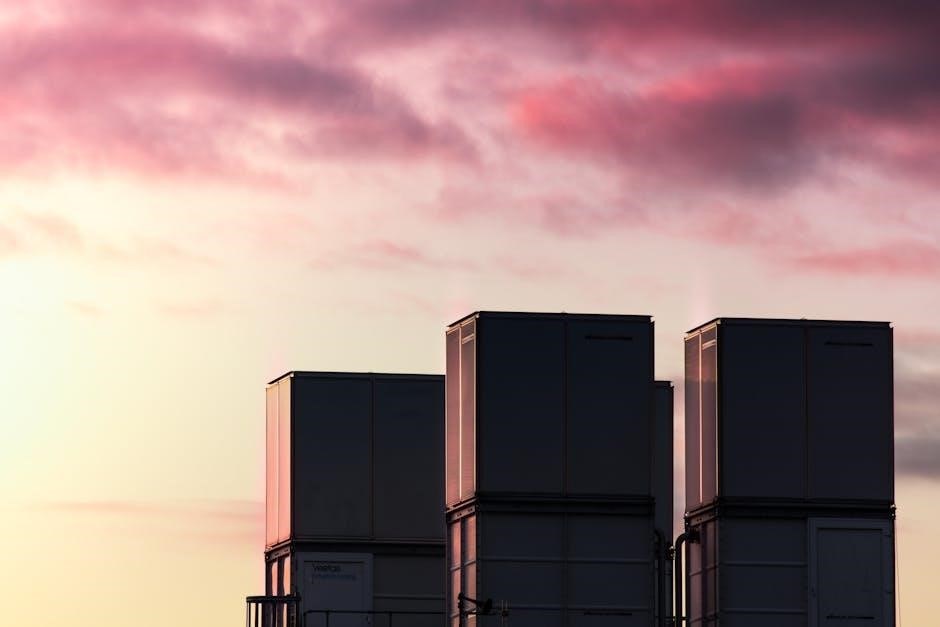Refrigeration and air conditioning technology are essential for maintaining thermal comfort and preserving materials. These systems are widely used in residential, commercial, and industrial applications, ensuring efficiency and sustainability in cooling processes.
1.1. Basic Overview of Refrigeration and Air Conditioning
Refrigeration and air conditioning are technologies that manage thermal energy to achieve desired temperatures. Refrigeration focuses on cooling materials below ambient temperature, while air conditioning regulates temperature, humidity, and air quality in spaces. Both systems are integral to modern life, enabling food preservation, industrial processes, and indoor comfort. They operate by transferring heat from a cooled space to an external environment, ensuring efficient thermal management across various applications.
1.2. Historical Evolution of Cooling Technologies
The development of refrigeration and air conditioning began with early methods like ice harvesting and ventilation. In the 19th century, mechanical refrigeration emerged with technologies such as vapor compression, pioneered by Oliver Evans and Jacob Perkins. The 20th century saw the rise of electric air conditioning by Willis Carrier, transforming indoor environments. Modern advancements include efficient compressors, eco-friendly refrigerants, and smart systems, driven by the need for energy conservation and environmental sustainability, marking significant milestones in cooling technology’s progression.

Fundamental Principles of Refrigeration
Refrigeration involves transferring heat from a cooler to a warmer location through compression, condensation, and expansion. It relies on thermodynamic principles to maintain low temperatures effectively.
2.1. Thermodynamic Basics and Heat Transfer
Thermodynamic principles govern refrigeration, involving energy transfer and temperature management. Heat transfer occurs through conduction, convection, and radiation, essential for efficient cooling systems. Understanding these processes ensures effective system design and operation.
2.2. Refrigeration Cycles: Vapor Compression, Absorption, and Evaporative Cooling
Refrigeration systems operate through cycles that transfer heat from a cooler to a warmer location. The vapor-compression cycle uses compressors and refrigerants, while absorption systems rely on heat and chemical processes. Evaporative cooling leverages water evaporation for natural cooling, enhancing efficiency and reducing environmental impact. Each method offers unique benefits, making them suitable for various applications in both industrial and residential settings.

Air Conditioning Systems
Air conditioning systems regulate temperature, humidity, and air quality, ensuring comfort and preserving materials. They are widely used in residential, commercial, and industrial settings for efficient climate control.
3.1. Principles of Air Conditioning and Humidity Control
Air conditioning systems operate by regulating temperature, humidity, and air quality to maintain thermal comfort. The process involves cooling, heating, and removing excess moisture from the air. Humidity control is critical to prevent condensation and ensure optimal indoor air quality. These systems use thermodynamic principles, such as evaporation and condensation, to transfer heat and manage moisture effectively. Proper air conditioning ensures comfort, reduces energy consumption, and prevents issues like mold growth, making it essential for both residential and commercial environments.
3.2. Components of Air Conditioning Systems: Compressors, Condensers, and Evaporators
The compressor is the heart of the air conditioning system, compressing refrigerant to facilitate heat transfer. Condensers cool the compressed refrigerant, often using fans or water, while evaporators absorb heat from the surrounding air, causing the refrigerant to evaporate. These components work together to maintain desired temperatures and humidity levels, ensuring efficient cooling and thermal comfort in various environments. Proper functioning of these parts is crucial for the overall performance of air conditioning systems.

Refrigerants and Their Role in Cooling Systems
Refrigerants are substances that transfer heat in cooling systems, enabling temperature reduction. They must be non-toxic, non-flammable, and have suitable thermodynamic properties. Eco-friendly options are increasingly prioritized to reduce environmental impact.
4.1. Properties and Classification of Refrigerants
Refrigerants are classified based on their thermodynamic and chemical properties, including latent heat, boiling point, and environmental impact. Common types include chlorofluorocarbons (CFCs), hydrofluorocarbons (HFCs), and natural refrigerants like ammonia and carbon dioxide; Each has distinct advantages, such as high efficiency or low global warming potential. Proper classification ensures compatibility with system design, safety, and regulatory compliance. Modern systems increasingly adopt eco-friendly alternatives to mitigate ozone depletion and climate change, aligning with global sustainability goals and reducing environmental risks.
4.2. Environmental Impact: Ozone Depletion and Global Warming Potential
The environmental impact of refrigerants is a critical concern, primarily due to ozone depletion and global warming potential (GWP). CFCs and HCFCs contribute to ozone layer degradation, while HFCs, though ozone-friendly, have high GWPs. Regulations like the Montreal Protocol phase out harmful refrigerants, promoting alternatives such as HFOs and natural refrigerants with low GWP. The transition to eco-friendly options is essential for mitigating climate change and ensuring sustainable cooling technologies. Industry efforts focus on reducing emissions and adopting environmentally responsible solutions to address these challenges effectively.

Commercial and Industrial Refrigeration Systems
Commercial and industrial refrigeration systems are vital for cooling large-scale applications, such as supermarkets, cold storage, and industrial processes, ensuring efficient temperature control and product preservation.
5.1. Applications in Supermarkets, Cold Storage, and Industrial Processes
Refrigeration systems are crucial in supermarkets for preserving perishables and maintaining display conditions. Cold storage facilities rely on advanced systems to keep goods at optimal temperatures, preventing spoilage. Industrial processes utilize specialized refrigeration to control temperatures in manufacturing, ensuring product quality and safety. These applications require precise temperature control, energy efficiency, and reliability to meet demanding operational needs and regulatory standards.
5.2. Specialized Refrigeration Systems for Large-Scale Operations
Large-scale operations demand customized refrigeration systems to handle massive cooling demands. Industrial facilities often employ ammonia or CO2 transcritical systems for efficiency and environmental benefits. Supermarkets and distribution centers use multi-stage compressors and advanced condenser designs to maintain uniform temperatures. These systems are designed for high capacity, energy efficiency, and reliability, ensuring continuous operation in demanding environments. They also incorporate smart controls and monitoring systems to optimize performance and reduce environmental impact, making them essential for modern industrial and commercial applications.

Residential and Small-Scale Cooling Solutions
Residential and small-scale cooling solutions provide efficient temperature control for homes and compact spaces, featuring window ACs, split systems, and domestic refrigeration units designed for energy efficiency and space-saving performance.
6.1. Window, Split, and Central Air Conditioning Systems
Window, split, and central air conditioning systems are popular residential cooling solutions. Window units are compact, cost-effective, and ideal for small spaces, while split systems offer quiet operation and flexibility. Central AC systems provide whole-house cooling through ductwork, ensuring uniform temperature control. Each system caters to different needs, with window ACs being easy to install and split systems offering aesthetic benefits. Central systems, though more complex, deliver superior comfort and energy efficiency, making them a preferred choice for larger homes and commercial spaces.
6.2. Domestic Refrigeration and Freezers: Design and Operation
Domestic refrigeration and freezers are essential appliances designed for food preservation. They operate on vapor-compression cycles, using refrigerants to transfer heat from the interior to the exterior. Modern designs emphasize energy efficiency, with features like smart sensors and adaptive compressors. Freezers maintain sub-zero temperatures for long-term storage, while refrigerators focus on consistent cooling. Advanced insulation and door seals minimize heat loss, ensuring optimal performance. These systems are user-friendly, with controls for temperature adjustment, defrosting, and energy-saving modes, making them indispensable for household needs.

Sustainability and Energy Efficiency in Cooling Technologies
Sustainability and energy efficiency are critical in cooling technologies, focusing on eco-friendly refrigerants, reduced energy consumption, and minimal environmental impact to meet global climate goals effectively.
7.1. Green Refrigerants and Eco-Friendly Cooling Solutions
Green refrigerants and eco-friendly cooling solutions are revolutionizing the industry by reducing environmental impact. Natural refrigerants like CO2, ammonia, and hydrocarbons offer low global warming potential. These alternatives minimize ozone depletion and align with global sustainability goals. Advanced systems, such as evaporative cooling and absorption technologies, enhance energy efficiency. Regulations and innovations drive the adoption of eco-friendly solutions, ensuring a greener future for cooling technologies while maintaining performance and reliability.
7.2. Energy Efficiency Standards and Regulations
Energy efficiency standards and regulations play a crucial role in shaping the refrigeration and air conditioning industry. Governments worldwide impose strict guidelines to reduce energy consumption and emissions. These standards promote the use of high-efficiency equipment and sustainable practices. Compliance with regulations ensures reduced environmental impact while maintaining system performance. Regular updates to these standards drive continuous innovation, encouraging manufacturers to develop cutting-edge technologies that meet both energy efficiency and environmental requirements, ultimately benefiting consumers and the planet.
Advanced Technologies in Refrigeration and Air Conditioning
Advanced technologies include inverter-driven compressors, smart sensors, and IoT-enabled systems, enhancing efficiency and performance. Innovations in heat exchanger designs and green refrigerants further reduce energy consumption and environmental impact.
8.1. Smart HVAC Systems and IoT Integration
Smart HVAC systems integrate IoT technology to optimize performance, enabling real-time monitoring and control. IoT devices, such as sensors and smart thermostats, collect data on temperature, humidity, and energy usage, improving system efficiency. Automation and machine learning algorithms analyze this data to predict maintenance needs, reducing downtime and operational costs. IoT-connected systems also allow remote access, enabling users to adjust settings via smartphones or voice assistants, enhancing convenience and energy savings. This integration supports sustainable practices by minimizing energy waste and promoting eco-friendly operation.
Advanced IoT features include adaptive learning, which tailors system operation to user preferences and usage patterns. Energy management systems leverage IoT data to balance load distribution and reduce peak demand. Additionally, smart HVAC systems can integrate with renewable energy sources, further reducing environmental impact. These technologies are reshaping the industry by prioritizing efficiency, sustainability, and user-centric design, ensuring smarter and more adaptable cooling solutions for modern applications.
8.2. Innovations in Compressor and Heat Exchanger Designs
Modern compressors feature advanced designs like variable-speed drives and inverter technology, optimizing performance and energy efficiency. These innovations reduce noise levels and operational costs while enhancing reliability. Heat exchangers now incorporate microchannel and plate-and-frame designs, improving heat transfer efficiency and reducing refrigerant charge. Advanced materials, such as corrosion-resistant alloys, extend equipment lifespan. These developments contribute to eco-friendly systems, lowering environmental impact while meeting stringent energy standards and regulations.
Additionally, compact compressor designs enable smaller, more versatile systems, ideal for urban and space-constrained applications. Smart sensors and IoT integration in compressors allow real-time monitoring and predictive maintenance, minimizing downtime. Heat exchangers with enhanced surface areas and flow patterns further maximize thermal performance. Together, these innovations drive the evolution of refrigeration and air conditioning technology, ensuring higher efficiency, sustainability, and adaptability to future challenges.

Maintenance, Troubleshooting, and Safety Practices
Regular maintenance ensures optimal performance and longevity of refrigeration and air conditioning systems. Preventive tasks include cleaning coils, checking refrigerant levels, and inspecting for leaks. Troubleshooting techniques help identify common issues like compressor failures or faulty sensors. Safety practices, such as proper refrigerant handling and wearing protective gear, are essential to prevent accidents and environmental hazards. Adhering to these practices ensures efficient, safe, and reliable system operation.
9.1. Best Practices for System Maintenance
Regular maintenance is crucial for ensuring the efficiency and longevity of refrigeration and air conditioning systems. Routine inspections should include cleaning condenser and evaporator coils, checking refrigerant levels, and inspecting for leaks. Additionally, ensuring proper airflow, verifying thermostat settings, and lubricating moving parts can prevent premature wear. Scheduling annual professional servicing helps identify potential issues before they escalate. Adhering to these best practices not only improves system performance but also reduces energy consumption and extends the lifespan of equipment, ensuring reliable operation year-round.
9.2. Common Issues and Troubleshooting Techniques
Common issues in refrigeration and air conditioning systems include refrigerant leaks, faulty compressors, and clogged air filters. Troubleshooting involves identifying symptoms like reduced cooling performance or unusual noises. Checking for blockages, verifying refrigerant levels, and inspecting electrical connections are key steps. Advanced techniques may require specialized tools to diagnose compressor faults or sensor malfunctions. Addressing these issues promptly prevents system failure and ensures optimal performance, minimizing downtime and operational costs while maintaining efficiency and reliability.

Global Trends and Future Outlook
The refrigeration and air conditioning industry is shifting toward sustainable technologies, with a focus on eco-friendly refrigerants and energy-efficient systems to address climate change and global energy demands.
10.1. Industry Growth and Technological Advancements
The refrigeration and air conditioning industry is experiencing rapid growth driven by increasing demand for cooling solutions and technological advancements. Innovations in smart HVAC systems, IoT integration, and eco-friendly refrigerants are reshaping the market. Energy-efficient designs and sustainable practices are becoming priorities, aligning with global efforts to reduce environmental impact. These advancements ensure the industry meets future challenges while maintaining high performance and reliability across various applications.
10.2. The Role of Refrigeration and Air Conditioning in Climate Change Mitigation
Refrigeration and air conditioning play a crucial role in climate change mitigation by reducing greenhouse gas emissions. Transitioning to eco-friendly refrigerants and energy-efficient systems lowers their environmental impact. Advanced technologies, such as smart HVAC systems, optimize performance while minimizing energy consumption. These innovations contribute to sustainable cooling solutions, helping to combat global warming and promote a greener future.

Resources and Further Reading
Key resources include textbooks like Refrigeration and Air Conditioning Technology, online courses, and manuals, offering in-depth knowledge and practical insights for professionals and students.
11.1. Key Textbooks and Manuals on Refrigeration and Air Conditioning
by Dr. Kirkpatrick, focusing on thermodynamic principles and sustainable practices. Additionally, Springer’s Refrigeration and Air Conditioning Systems provides detailed analyses of cooling technologies and environmental impacts. These manuals are invaluable for students and professionals seeking to deepen their understanding of modern cooling technologies and their applications.
11.2. Online Courses and Certification Programs
Online courses and certification programs offer flexible learning opportunities for refrigeration and air conditioning technology. Platforms like Coursera, Udemy, and edX provide courses covering fundamentals, system design, and sustainable practices. Certifications such as HVAC Technician Certification and Energy Efficiency Specialist are highly regarded. These programs cater to both beginners and professionals, ensuring up-to-date knowledge on modern cooling technologies and industry standards, while enhancing career prospects in the HVAC/R field.

